DR-ALOHA-Q: A Q-Learning-Based Adaptive MAC Protocol for Underwater Acoustic Sensor Networks
Abstract
:1. Introduction
- We define DR-ALOHA-Q as a framed-ALOHA MAC scheme that selects optimal time slots and time offsets for packet transmissions for UASN nodes. As we will show later in the paper, joint optimization of time-slot selection and transmission offset enables DR-ALOHA-Q to achieve high channel utilization at a reasonable convergence speed. Therefore, clock synchronization is not required;
- We formulate the MAC problem as a decentralized multiagent reinforcement learning problem with a delayed reward. A computationally efficient RL model is run independently on each sensor node, without requiring any information exchange among the nodes. The total number of network nodes is the only global information assumed to be known locally. To maximize the network throughput, DR-ALOHA-Q deviates from the usual RL approach with an immediate reward mechanism, which is not suitable for environments with long propagation delays.
- Hysteretic Q-learning [8] is applied to enhance the convergence properties of the algorithm;
- We evaluate the performance of DR-ALOHA-Q through a series of simulations and compare it with UW-ALOHA-Q, [3], DOTS [9], and CS-ALOHA [10] for a wide range of static and mobile network scenarios. Our results show that DR-ALOHA-Q achieves significant improvements in terms of channel utilization. Furthermore, even when considering higher channel utilization targets, DR-ALOHA-Q achieves faster convergence times than UW-ALOHA-Q.
2. Related Work
3. Scenario and Network Model
3.1. Reinforcement Learning Technique
3.2. DR-ALOHA-Q MAC Protocol
3.2.1. A Model for Transmitting Packets
3.2.2. Learning to Avoid Collisions
4. Simulation Results
4.1. Benchmark Protocols
4.2. Investigated Metrics
4.3. Simulation of Static UASN
4.4. Simulation of a Free-Floating UASN
5. Conclusions
Author Contributions
Funding
Institutional Review Board Statement
Informed Consent Statement
Data Availability Statement
Conflicts of Interest
References
- Jouhari, M.; Ibrahimi, K.; Tembine, H.; Ben-Othman, J. Underwater Wireless Sensor Networks: A Survey on Enabling Technologies, Localization Protocols, and Internet of Underwater Things. IEEE Access 2019, 7, 96879–96899. [Google Scholar] [CrossRef]
- Sendra, S.; Lloret, J.; Jimenez, J.M.; Parra, L. Underwater Acoustic Modems. IEEE Sens. J. 2016, 16, 4063–4071. [Google Scholar] [CrossRef]
- Park, S.H.; Mitchell, P.D.; Grace, D. Reinforcement Learning Based MAC Protocol (UW-ALOHA-Q) for Underwater Acoustic Sensor Networks. IEEE Access 2019, 7, 165531–165542. [Google Scholar] [CrossRef]
- Hsu, C.C.; Kuo, M.S.; Chou, C.F.; Lin, K.C.J. The Elimination of Spatial-Temporal Uncertainty in Underwater Sensor Networks. IEEE/ACM Trans. Netw. 2013, 21, 1229–1242. [Google Scholar] [CrossRef]
- Agiwal, M.; Roy, A.; Saxena, N. Next Generation 5G Wireless Networks: A Comprehensive Survey. IEEE Commun. Surv. Tutorials 2016, 18, 1617–1655. [Google Scholar] [CrossRef]
- Gunn, M.; Koo, S.G.M. A Comparative Study of Medium Access Control Protocols for Wireless Sensor Networks. Int. J. Commun. Netw. Syst. Sci. 2009, 2, 695–703. [Google Scholar] [CrossRef]
- Park, S.H.; Mitchell, P.D.; Grace, D. Reinforcement Learning Based MAC Protocol (UW-ALOHA-QM) for Mobile Underwater Acoustic Sensor Networks. IEEE Access 2021, 9, 5906–5919. [Google Scholar] [CrossRef]
- Matignon, L.; Laurent, G.J.; Le Fort-Piat, N. Hysteretic Q-learning: An algorithm for Decentralized Reinforcement Learning in Cooperative Multi-Agent Teams. In Proceedings of the 2007 IEEE/RSJ International Conference on Intelligent Robots and Systems, San Diego, CA, USA, 29 October–2 November 2007; pp. 64–69. [Google Scholar] [CrossRef]
- Noh, Y.; Wang, P.; Lee, U.; Torres, D.; Gerla, M. DOTS: A propagation Delay-aware Opportunistic MAC protocol for underwater sensor networks. In Proceedings of the 18th IEEE International Conference on Network Protocols, Kyoto, Japan, 5–8 October 2010; pp. 183–192. [Google Scholar] [CrossRef]
- Vieira, L.F.M.; Kong, J.; Lee, U.; Gerla, M. Analysis of Aloha Protocols for Underwater Acoustic Sensor Networks. Available online: https://www.semanticscholar.org/paper/Analysis-of-Aloha-Protocols-for-Underwater-Acoustic-Vieira-Kong/095862fcbbbde81ba0cbb51831276e8c0e70accb (accessed on 16 April 2023).
- Yackoski, J.; Shen, C.C. UW-FLASHR: Achieving High Channel Utilization in a Time-Based Acoustic Mac Protocol. In Proceedings of the 3rd International Workshop on Underwater Networks, New York, NY, USA, 15 September 2008; WUWNet ’08; pp. 59–66. [Google Scholar] [CrossRef]
- Hsu, C.C.; Lai, K.F.; Chou, C.F.; Lin, K.C.J. ST-MAC: Spatial-Temporal MAC Scheduling for Underwater Sensor Networks. In Proceedings of the IEEE INFOCOM 2009, Rio de Janeiro, Brazil, 19–25 April 2009; pp. 1827–1835. [Google Scholar] [CrossRef]
- Kredo II, K.; Djukic, P.; Mohapatra, P. STUMP: Exploiting Position Diversity in the Staggered TDMA Underwater MAC Protocol. In Proceedings of the IEEE INFOCOM 2009, Rio de Janeiro, Brazil, 19–25 April 2009; pp. 2961–2965. [Google Scholar] [CrossRef]
- Zhuo, X.; Qu, F.; Yang, H.; Wei, Y.; Wu, Y.; Li, J. Delay and Queue Aware Adaptive Scheduling- Based MAC Protocol for Underwater Acoustic Sensor Networks. IEEE Access 2019, 7, 56263–56275. [Google Scholar] [CrossRef]
- Peleato, B.; Stojanovic, M. Distance aware collision avoidance protocol for ad-hoc underwater acoustic sensor networks. IEEE Commun. Lett. 2007, 11, 1025–1027. [Google Scholar] [CrossRef]
- Molins, M.; Stojanovic, M. Slotted FAMA: A MAC protocol for underwater acoustic networks. In Proceedings of the OCEANS 2006–Asia Pacific, Singapore, 16–19 May 2006; pp. 1–7. [Google Scholar]
- Ng, H.H.; Soh, W.S.; Motani, M. MACA-U: A Media Access Protocol for Underwater Acoustic Networks. In Proceedings of the IEEE GLOBECOM 2008–2008 IEEE Global Telecommunications Conference, New Orleans, LA, USA, 30 November–4 December 2008; pp. 1–5. [Google Scholar] [CrossRef]
- Guo, X.; Frater, M.R.; Ryan, M.J. Design of a Propagation-Delay-Tolerant MAC Protocol for Underwater Acoustic Sensor Networks. IEEE J. Ocean. Eng. 2009, 34, 170–180. [Google Scholar] [CrossRef]
- Abramson, N. The ALOHA SYSTEM: Another Alternative for Computer Communications. In Proceedings of the Fall Joint Computer Conference, New York, NY, USA, 17–19 November 1970; AFIPS ’70 (Fall). pp. 281–285. [Google Scholar] [CrossRef]
- Chirdchoo, N.; Soh, W.S.; Chua, K.C. Aloha-Based MAC Protocols with Collision Avoidance for Underwater Acoustic Networks. In Proceedings of the IEEE INFOCOM 2007–26th IEEE International Conference on Computer Communications, Washington, DC, USA, 1–12 May 2007; pp. 2271–2275. [Google Scholar] [CrossRef]
- Syed, A.A.; Ye, W.; Heidemann, J.; Krishnamachari, B. Understanding Spatio-Temporal Uncertainty in Medium Access with ALOHA Protocols. In Proceedings of the 2nd Workshop on Underwater Networks, Montreal, QC, Canada, 14 September 2007; WUWNet ’07; pp. 41–48. [Google Scholar] [CrossRef]
- Zhou, Y.; Chen, K.; He, J.; Guan, H. Enhanced Slotted Aloha Protocols for Underwater Sensor Networks with Large Propagation Delay. In Proceedings of the 2011 IEEE 73rd Vehicular Technology Conference (VTC Spring), Budapest, Hungary, 15–18 May 2011; pp. 1–5. [Google Scholar] [CrossRef]
- Syed, A.A.; Ye, W.; Heidemann, J. T-Lohi: A New Class of MAC Protocols for Underwater Acoustic Sensor Networks. In Proceedings of the IEEE INFOCOM 2008–The 27th Conference on Computer Communications, Phoenix, AZ, USA, 13–18 April 2008; pp. 231–235. [Google Scholar] [CrossRef]
- Jin, L.; Huang, D.D. A slotted CSMA based reinforcement learning approach for extending the lifetime of underwater acoustic wireless sensor networks. Comput. Commun. 2013, 36, 1094–1099. [Google Scholar] [CrossRef]
- Ahmed, F.; Cho, H.S. A Time-Slotted Data Gathering Medium Access Control Protocol Using Q-Learning for Underwater Acoustic Sensor Networks. IEEE Access 2021, 9, 48742–48752. [Google Scholar] [CrossRef]
- Cho, J.; Ahmed, F.; Shitiri, E.; Cho, H.S. Power Control for MACA-based Underwater MAC Protocol: A Q-Learning Approach. In Proceedings of the 2021 IEEE Region 10 Symposium (TENSYMP), Grand Hyatt Jeju, Republic of Korea, 23–25 August 2021; pp. 1–4. [Google Scholar] [CrossRef]
- Gazi, F.; Ahmed, N.; Misra, S.; Wei, W. Reinforcement Learning-Based MAC Protocol for Underwater Multimedia Sensor Networks. ACM Trans. Sen. Netw. 2022, 18, 1–25. [Google Scholar] [CrossRef]
- Alhassan, I.B.; Mitchell, P.D. Packet Flow Based Reinforcement Learning MAC Protocol for Underwater Acoustic Sensor Networks. Sensors 2021, 21, 2284. [Google Scholar] [CrossRef] [PubMed]
- Park, S.H.; Mitchell, P.D.; Grace, D. Performance of the ALOHA-Q MAC Protocol for Underwater Acoustic Networks. In Proceedings of the 2018 International Conference on Computing, Electronics and Communications Engineering (iCCECE), Southend, UK, 16–17 August 2018; pp. 189–194. [Google Scholar] [CrossRef]
- Ye, X.; Yu, Y.; Fu, L. Deep Reinforcement Learning Based MAC Protocol for Underwater Acoustic Networks. IEEE Trans. Mob. Comput. 2022, 21, 1625–1638. [Google Scholar] [CrossRef]
- Liu, E.; He, R.; Chen, X.; Yu, C. Deep Reinforcement Learning Based Optical and Acoustic Dual Channel Multiple Access in Heterogeneous Underwater Sensor Networks. Sensors 2022, 22, 1628. [Google Scholar] [CrossRef] [PubMed]
- Roberts, L.G. ALOHA Packet System with and without Slots and Capture. ACM SIGCOMM Comput. Commun. Rev. 1975, 5, 28–42. [Google Scholar] [CrossRef]
- EvoLogics. 2022. Available online: https://evologics.de/acoustic-modem/18-34 (accessed on 12 March 2023).
- Caruso, A.; Paparella, F.; Vieira, L.F.M.; Erol, M.; Gerla, M. The Meandering Current Mobility Model and its Impact on Underwater Mobile Sensor Networks. In Proceedings of the IEEE INFOCOM 2008–The 27th Conference on Computer Communications, Phoenix, AZ, USA, 13–18 April 2008; pp. 221–225. [Google Scholar] [CrossRef]
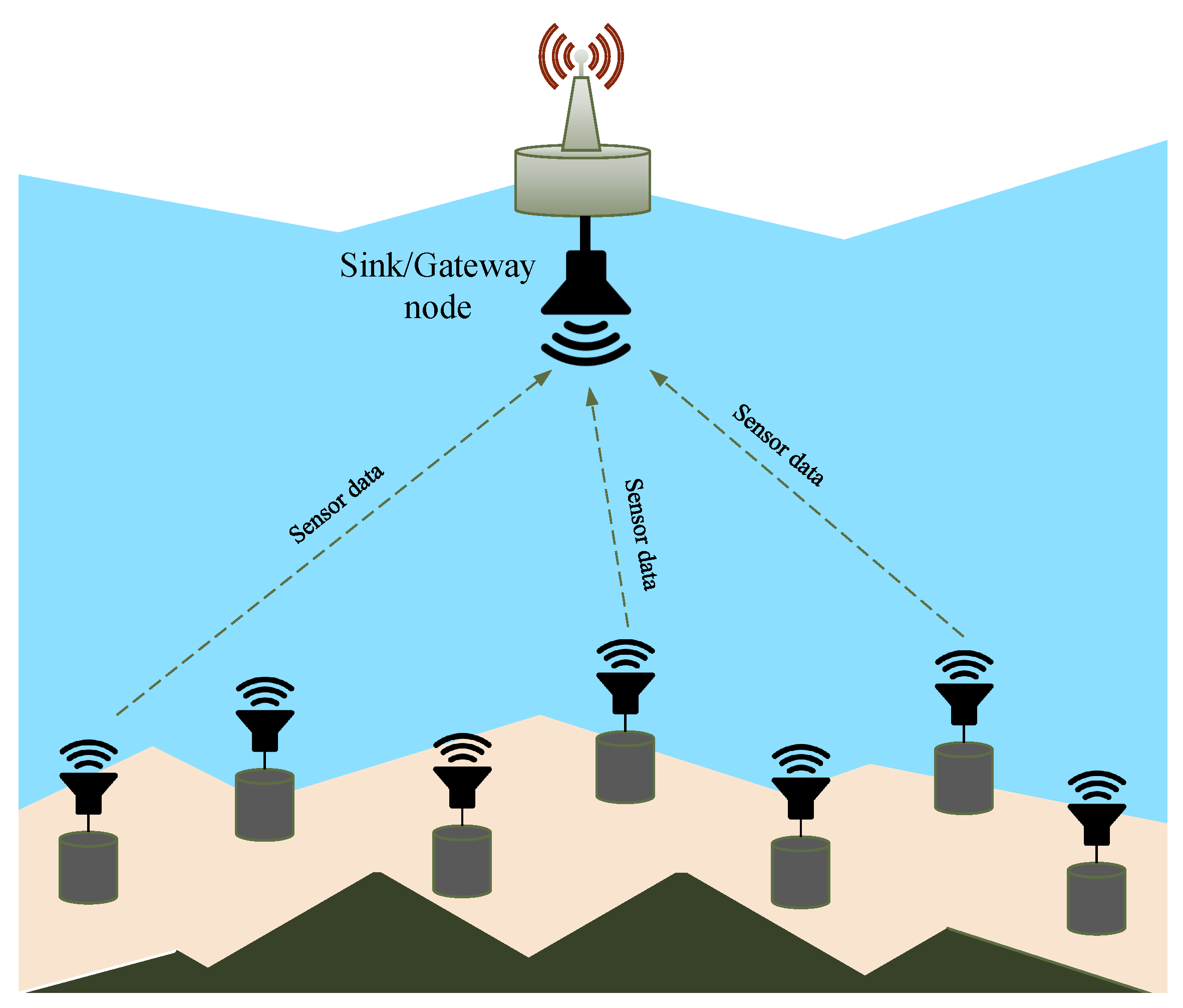


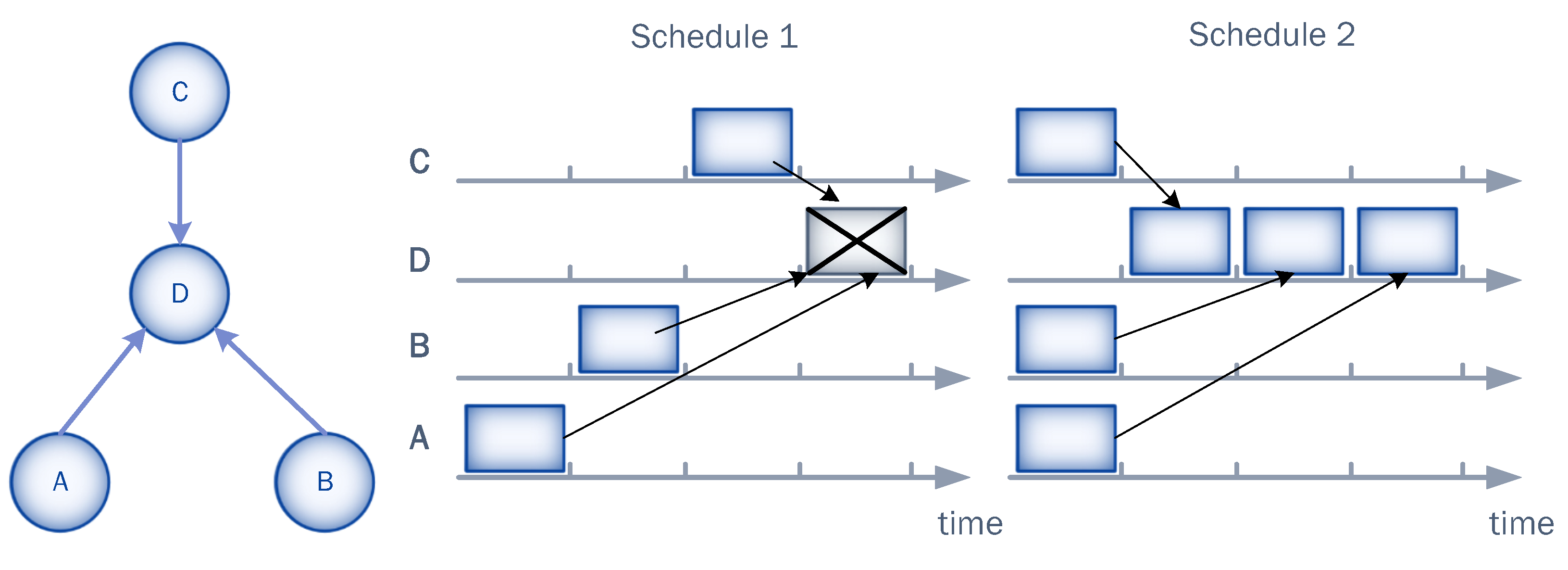


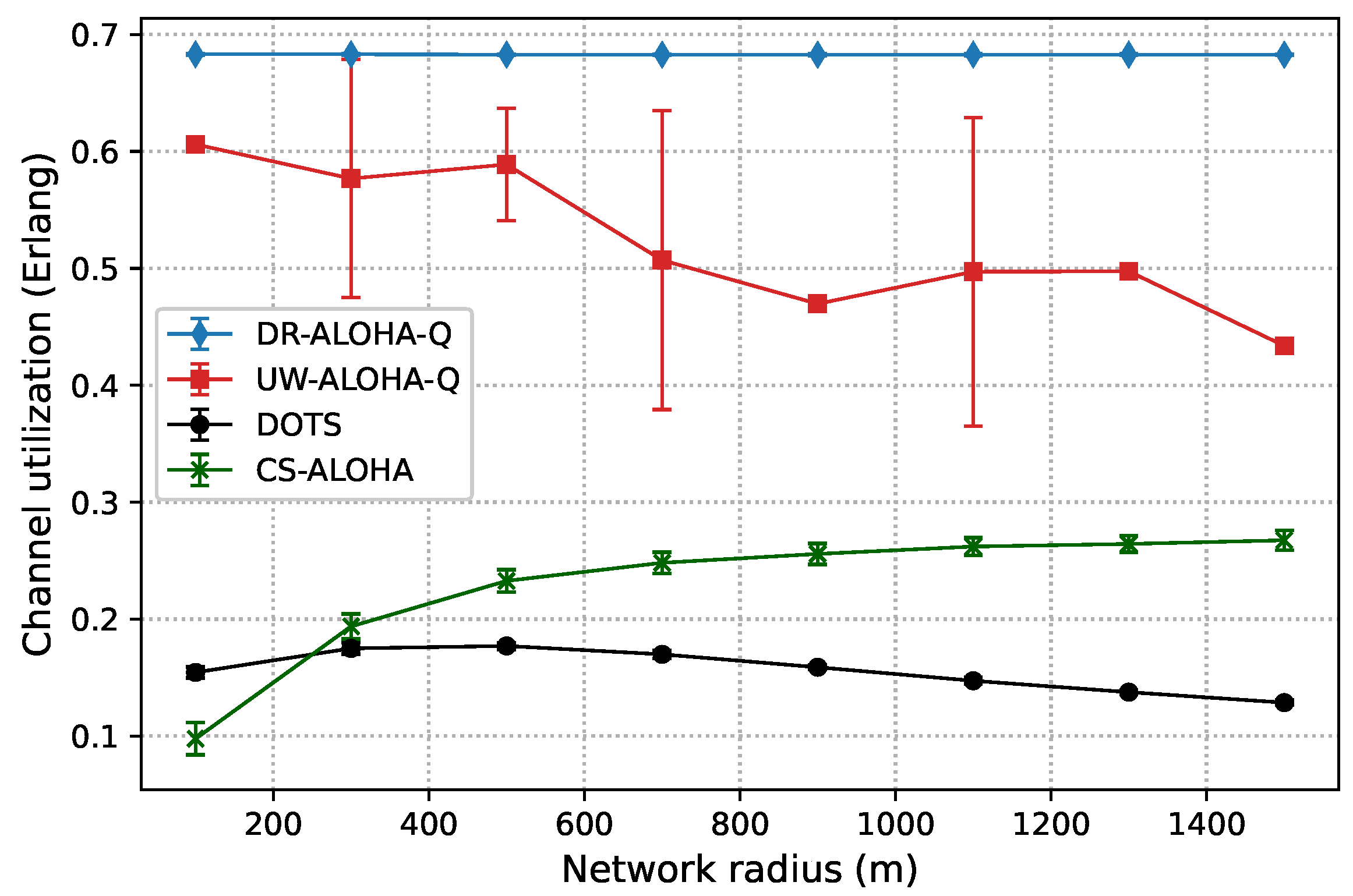



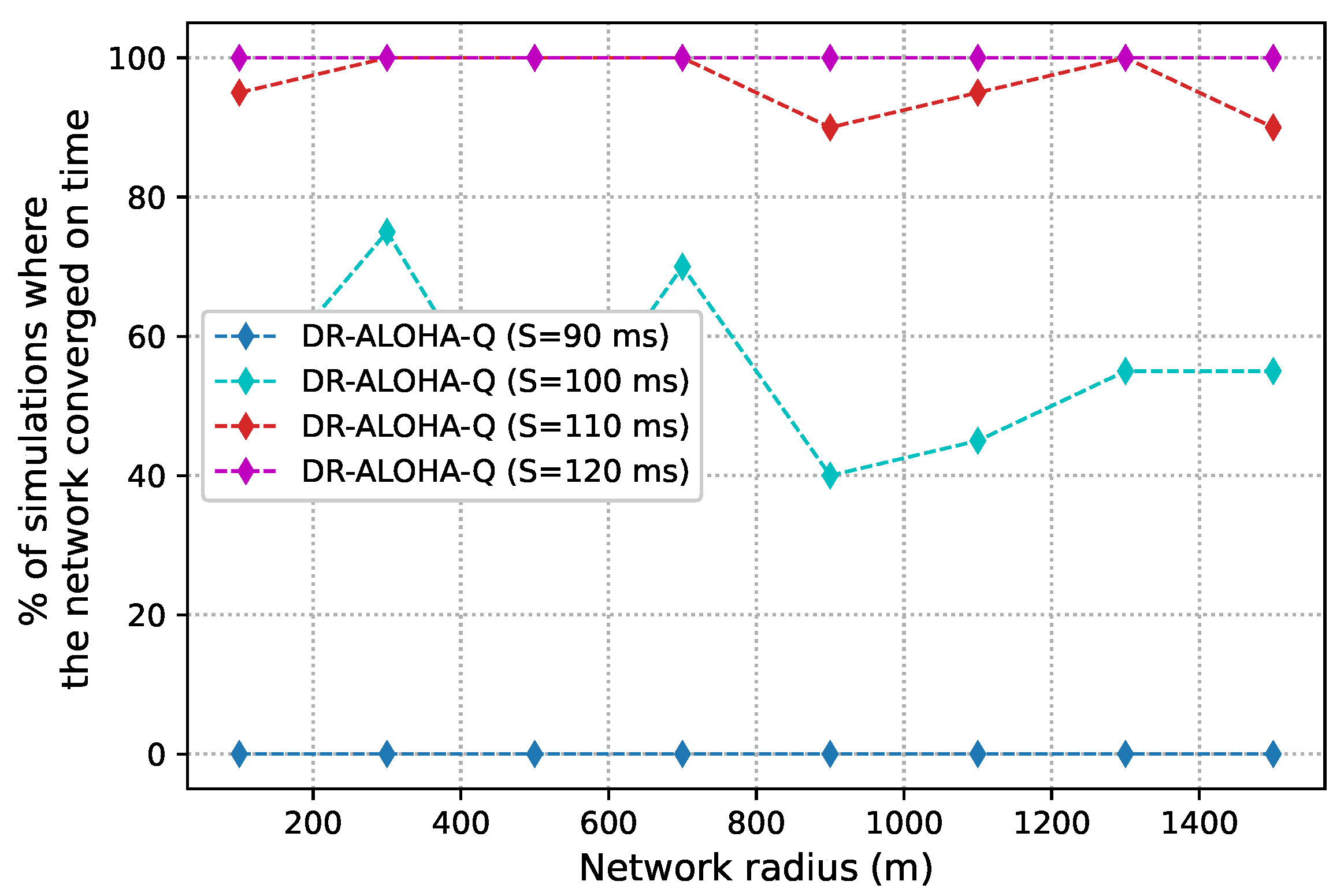


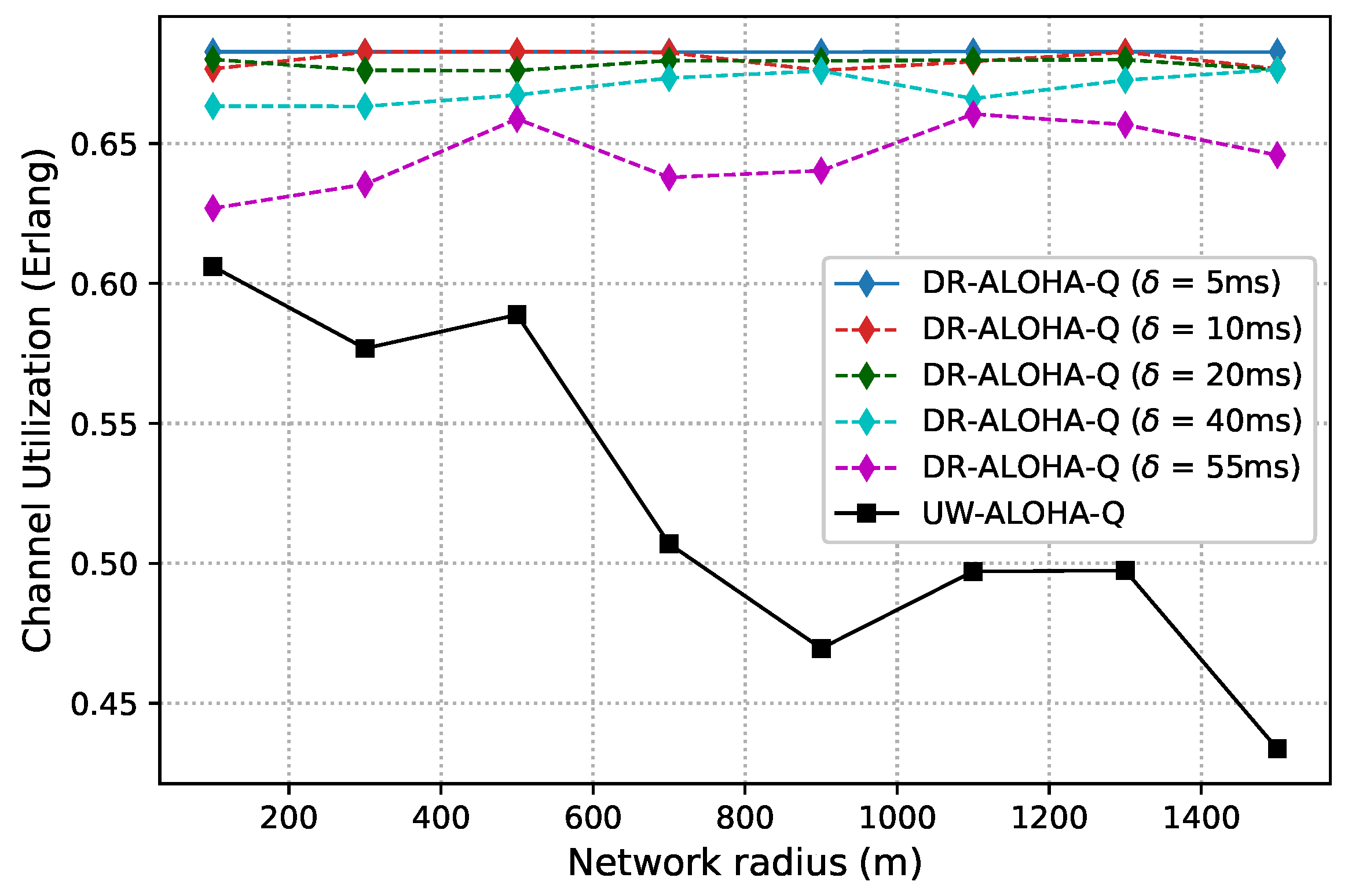


| Parameter | Value |
|---|---|
| Data packet size | 1044 bits |
| ACK packet size | 20 bits |
| Data packet transmission time () | 75.108 ms |
| ACK packet transmission time () | 1.439 |
| Slot duration | 110 ms |
| Propagation speed | 1500 m/s |
| Transmission rate | 13,900 bps |
| Learning rate | 0.1 |
| Learning rate | 0.01 |
| Time-offset step | 5 ms |
| Protocol Name | Network Radius in Meters | Convergence Time in Seconds | % of Simulations Where the Network Vonverges |
|---|---|---|---|
| DR-ALOHA-Q (S = 110 ms) | 100 | 31.93 | 100% |
| DR-ALOHA-Q (S = 120 ms) | 100 | 28.55 | 100% |
| UW-ALOHA-Q | 100 | 25.93 | 100% |
| DR-ALOHA-Q (S = 110 ms) | 300 | 31.26 | 85% |
| DR-ALOHA-Q (S = 120 ms) | 300 | 26.18 | 100% |
| UW-ALOHA-Q | 300 | 27.44 | 100% |
| DR-ALOHA-Q (S = 110 ms) | 500 | 36.06 | 95% |
| DR-ALOHA-Q (S = 120 ms) | 500 | 32.77 | 100% |
| UW-ALOHA-Q | 500 | 23.69 | 100% |
| DR-ALOHA-Q (S = 110 ms) | 700 | 40.89 | 100% |
| DR-ALOHA-Q (S = 120 ms) | 700 | 34.55 | 100% |
| UW-ALOHA-Q | 700 | 19.47 | 100% |
| DR-ALOHA-Q (S = 110 ms) | 900 | 36.58 | 95% |
| DR-ALOHA-Q (S = 120 ms) | 900 | 33.31 | 100% |
| UW-ALOHA-Q | 900 | 245.41 | 100% |
| DR-ALOHA-Q (S = 110 ms) | 1100 | 39.66 | 95% |
| DR-ALOHA-Q (S = 120 ms) | 1100 | 34.66 | 100% |
| UW-ALOHA-Q | 1100 | 168.02 | 100% |
| DR-ALOHA-Q (S = 110 ms) | 1300 | 47.48 | 100% |
| DR-ALOHA-Q (S = 120 ms) | 1300 | 39.58 | 100% |
| UW-ALOHA-Q | 1300 | 120.12 | 100% |
| DR-ALOHA-Q (S = 110 ms) | 1500 | 47.53 | 90% |
| DR-ALOHA-Q (S = 120 ms) | 1500 | 41.69 | 100% |
| UW-ALOHA-Q | 1500 | 92.54 | 100% |
| Protocol Name | Network Radius in Meters | Convergence Time in Seconds | % of Simulations Where the Network Vonverges |
|---|---|---|---|
| DR-ALOHA-Q (S = 110 ms) | 100 | 199.48 | 100% |
| DR-ALOHA-Q (S = 120 ms) | 100 | 135.86 | 100% |
| UW-ALOHA-Q | 100 | 360.57 | 100% |
| DR-ALOHA-Q (S = 110 ms) | 300 | 181.46 | 100% |
| DR-ALOHA-Q (S = 120 ms) | 300 | 143.92 | 100% |
| UW-ALOHA-Q | 300 | 2054.03 | 80% |
| DR-ALOHA-Q (S = 110 ms) | 500 | 183.96 | 100% |
| DR-ALOHA-Q (S = 120 ms) | 500 | 121.74 | 100% |
| UW-ALOHA-Q | 500 | 3246.2 | 90% |
| DR-ALOHA-Q (S = 110 ms) | 700 | 250.25 | 100% |
| DR-ALOHA-Q (S = 120 ms) | 700 | 123.47 | 100% |
| UW-ALOHA-Q | 700 | 1909.9 | 65% |
| DR-ALOHA-Q (S = 110 ms) | 900 | 189 | 100% |
| DR-ALOHA-Q (S = 120 ms) | 900 | 182.67 | 100% |
| UW-ALOHA-Q | 900 | 177.97 | 100% |
| DR-ALOHA-Q (S = 110 ms) | 1100 | 194.62 | 100% |
| DR-ALOHA-Q (S = 120 ms) | 1100 | 132.26 | 100% |
| UW-ALOHA-Q | 1100 | 1808.55 | 70% |
| DR-ALOHA-Q (S = 110 ms) | 1300 | 208.66 | 100% |
| DR-ALOHA-Q (S = 120 ms) | 1300 | 136.3 | 100% |
| UW-ALOHA-Q | 1300 | 282.67 | 100% |
| DR-ALOHA-Q (S = 110 ms) | 1500 | 244.46 | 100% |
| DR-ALOHA-Q (S = 120 ms) | 1500 | 123.76 | 100% |
| UW-ALOHA-Q | 1500 | 176.83 | 100% |
| (ms) | Network Radius in Meters | Convergence Time in Frames | % of Simulations Where the Network Converges |
|---|---|---|---|
| 5 | 500 | 50.58 | 95% |
| 10 | 500 | 36.37 | 95% |
| 20 | 500 | 40.23 | 85% |
| 40 | 500 | 35 | 70% |
| 55 | 500 | 26.29 | 70% |
| (ms) | Network Radius in Meters | Convergence Time in Frames | % of Simulations Where the Network Converges |
|---|---|---|---|
| 5 | 500 | 59.2 | 100% |
| 10 | 500 | 69.65 | 100% |
| 20 | 500 | 55.72 | 90% |
| 40 | 500 | 46.73 | 75% |
| 55 | 500 | 44.77 | 65% |
Disclaimer/Publisher’s Note: The statements, opinions and data contained in all publications are solely those of the individual author(s) and contributor(s) and not of MDPI and/or the editor(s). MDPI and/or the editor(s) disclaim responsibility for any injury to people or property resulting from any ideas, methods, instructions or products referred to in the content. |
© 2023 by the authors. Licensee MDPI, Basel, Switzerland. This article is an open access article distributed under the terms and conditions of the Creative Commons Attribution (CC BY) license (https://creativecommons.org/licenses/by/4.0/).
Share and Cite
Tomovic, S.; Radusinovic, I. DR-ALOHA-Q: A Q-Learning-Based Adaptive MAC Protocol for Underwater Acoustic Sensor Networks. Sensors 2023, 23, 4474. https://doi.org/10.3390/s23094474
Tomovic S, Radusinovic I. DR-ALOHA-Q: A Q-Learning-Based Adaptive MAC Protocol for Underwater Acoustic Sensor Networks. Sensors. 2023; 23(9):4474. https://doi.org/10.3390/s23094474
Chicago/Turabian StyleTomovic, Slavica, and Igor Radusinovic. 2023. "DR-ALOHA-Q: A Q-Learning-Based Adaptive MAC Protocol for Underwater Acoustic Sensor Networks" Sensors 23, no. 9: 4474. https://doi.org/10.3390/s23094474





